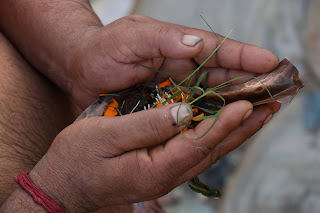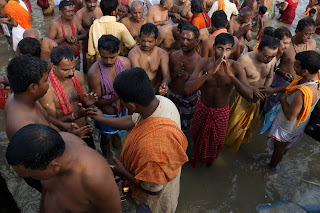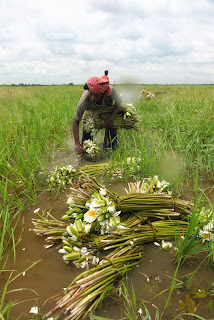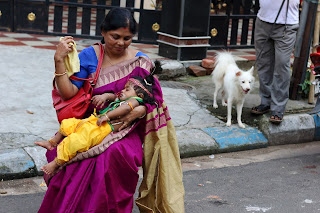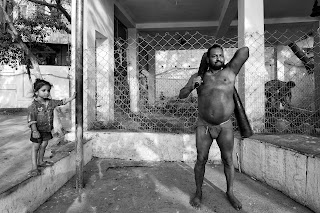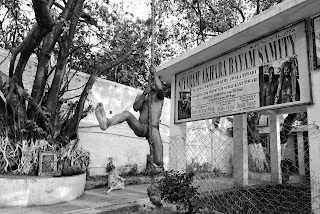17 September 2020, Kolkata, India ; Mahalaya is an integral occasion in the ethos of West Bengal as it marks the ushering of the festive spirit. It has two dimensions, namely, Devipaksha or the prayer which is offered to God and Pitripaksha or the worship and penance of one’s ancestor. Pitripaksha is also known as Shraddha or the ritual in which food is offered with a sense of affection and gratitude. On this day, Hindus pay their respect to their ancestors and this is known as Pindadana. On this very day Pitripaksha ends and the Devipaksha begins. Mahalaya is also the most suitable time for tantric practices and offering to the Goddess Chandi. Occurring every year in autumn or the 'sharot kaal', Mahalaya reminds every Bengali of Durga Puja that commences exactly after seven days. It is believed that the Goddess Durga pays a visit to the earth for a period of four days only and Mahalaya marks a kind of invitation to the mother goddess to descend on earth through chanting mantras.
©Ayan Biswas
I am a Photographer, Love to explore different places and clicks some photos.
Thursday, September 17, 2020
Mahalaya Torpon
Mahalaya is the last day of the Pitru Paksha and is also observed as the final day to conduct the shraadh ceremony if one has missed any of the dates during the preceding fortnight. Bengalis take a dip in the holy Ganga and some even perform torpon for their departed relatives. Mahalaya also heralds the festive period. With the Pitru Paksha over, it announces the Devi Paksha where Devi Durga is invoked with “jago tumi jago” which is an invitation for the goddess to come to earth.
Each year, people go to the river Ganges to wash their sins, and pray for the well being of their ancestors. They offer food, water and prayers for them. Kolkata – the city of joy, being at the last end of the river, is the home to the biggest prayers. A place where the urban chaos and the rustic mayhem both gather in unison. The Ghats are filled up with people who come from different stratas.
- by Ayan Biswas
Wednesday, August 26, 2020
Waterlogged In City Life
26 August 2020, Kolkata, India ; Every year, waterlogging takes place in a large area of identified some pockets in Sukia Street, Madan Mohan Burman Road, and Mahatma Gandhi Road where there is some technical problem and water takes reasonably longer time to drain out in comparison to some other parts of the city where water accumulates when there is reasonably heavy rainfall. Utility services of metro rail and water supply pipeline underground acts as barrier to drainage infrastructure.

Given all these factors that cause waterlogging, it is quite certain that Kolkatans have to resign themselves to remaining under water after every heavy downpour for a few hours, at least in the immediate future.

 Heavy siltation has drastically reduced the carrying capacity of the Hooghly river. Dredging is mostly perfunctory and even so, it is impossible to pump out the city’s storm water to the Hooghly when it gets swollen during high tide.
Heavy siltation has drastically reduced the carrying capacity of the Hooghly river. Dredging is mostly perfunctory and even so, it is impossible to pump out the city’s storm water to the Hooghly when it gets swollen during high tide.- by Ayan Biswas
Wednesday, August 19, 2020
Hard Working For Plucking Water Lilies
19 August 2020, Barasat, India; A few used small rafts while others swam to the core areas in the lakes , pond to pick the booming water lilies floating on the surface, much to the delight of the local villagers.
Despite there commonness, their delicate beauty means that they're always a desirable commodity. As a result, local farmers take their boats out into nearby lakes to harvest waterlilies to sell in markets, the largest and most common lily market.
- by Ayan Biswas
Despite there commonness, their delicate beauty means that they're always a desirable commodity. As a result, local farmers take their boats out into nearby lakes to harvest waterlilies to sell in markets, the largest and most common lily market.
The exotic water lilies forms an indispensable part of the puja material used during the Ganesha festival. It’s a customary practice to decorate the idols with a bunch of colourful water lilies. This is a season time flowers.
- by Ayan Biswas
Wednesday, August 12, 2020
Janmastami At Kolkata
12 August 2020 , Kolkata, India ; Krishna Janmashtami or the birthday of Lord Krishna is one of the most revered festivals of Hindus, hence celebrated with immense vibrancy across the country. Besides praying the Lord, devotees also get their kids dressed-up as Lord Krishna as a signature celebration of Janmashtami. Collected here are some cute photos of this beautiful celebration that will surely flash a big smile on your face.
 This picture is gonna stay in your mind forever.Exuding a huge dose of innocence, this adolescent dressed as Lord Krishna is cuteness overloaded.
This picture is gonna stay in your mind forever.Exuding a huge dose of innocence, this adolescent dressed as Lord Krishna is cuteness overloaded.
Every year on Janmashtami, several kids flock to the Partha Sarathi Mandir at Belaghata to participate in a competition where they all dress up as Lord Krishna and Radha. Little girl Samriddhi, who chose to dress up as Bal Gopal instead of Radha, won our hearts in the event.

 To me, culture involves a number of things. It involves food, language, festivals, clothes, habits and more.
To me, culture involves a number of things. It involves food, language, festivals, clothes, habits and more.
So, when next generations learns about all of this with the help of theatre, it helps in developing personality.”Cultural storytelling not only preserves traditions but also assists in passing knowledge about our civilisation from one generation to another. This form of art also allows children to express, explore and understand different traditions and cultures.
- by Ayan Biswas
Sunday, August 9, 2020
Village Dhobi Khana
9 August 2020 , Nadia; Their traditional occupation was washing clothes. The word dhobi is derived from the Hindi word dhona, which means to wash.
Dhobis in various regions are likely to be of many different ethnic origins: their ancestors took the occupation of washing clothes, evolving over time into a distinct caste bound by rules of endogamy. Most Dhobis follow the customs and traditions of the region they live. Washermen at Dhobi ghat are washing laundry in the pond.
There are 50 families doing this washing the clothes. They start their work at 6 a.m to 2.30 p.m. Everyday they washed 250 - 300 Clothes and Sarees.
Dhobis in various regions are likely to be of many different ethnic origins: their ancestors took the occupation of washing clothes, evolving over time into a distinct caste bound by rules of endogamy. Most Dhobis follow the customs and traditions of the region they live. Washermen at Dhobi ghat are washing laundry in the pond.
There are 50 families doing this washing the clothes. They start their work at 6 a.m to 2.30 p.m. Everyday they washed 250 - 300 Clothes and Sarees.
Sunday, August 2, 2020
Kidderpore Goat Market
2 August 2020, Kolkata, India ; As the city prepared for Eid sacrifices over the last fortnight, prices soared dramatically at the city’s largest goat fair near Kidderpore. From Black Bengal Goats to Totaparis and Sirohis to Jamunaparis, the fair held near Syed Baba Mazar has a lot to offer. But the price range may leave you shocked.
Coming all the way from Aligarh in
Uttar Pradesh, Md Shamshad — one of the sellers at the fair — boasted of having the biggest goat. Several factors including the breed and weight determine the price of the animal, he explained. “Generally, the Totaparis and Jamunaparis are the costliest as they are the biggest breeds found in India.
Coming all the way from Aligarh in
Uttar Pradesh, Md Shamshad — one of the sellers at the fair — boasted of having the biggest goat. Several factors including the breed and weight determine the price of the animal, he explained. “Generally, the Totaparis and Jamunaparis are the costliest as they are the biggest breeds found in India.
While Jamunaparis can weigh up to 80kg-100kg, a Totapari can be as heavy as 150kg,” said Shamshad. It is not unusual for prices to go up to Rs 1.75 lakh to Rs 2 lakh, he added. Thousands visited the fair this year and truckloads of goats were sold. But some buyers felt the pricing was unfair this year and many had to return without a purchase.
Sunday, July 26, 2020
Kusti in Kolkata
26 July 2020, Kolkata, India ; Kushti is an indigenous form of Indian wrestling tracing back three thousand years to the time of “malla-yuddha,” with Mughal refinements added in the 16th century. Kolkata is not a center for kushti like some north Indian towns such as Varanasi, Mathura and Allahabad. Yet, an early morning visit to the akharas behind Mullick Ghat on the banks of the Hooghly can be a novel and refreshing experience for a photographer in the “City of Joy.”
- by Ayan Biswas
Kushti is India's traditional wrestling, and is an ancient form of wrestling. It was held in great importance in Indian societies, but its popularity has dwindled over the years, although there are concerted efforts to revive it. Kushti practitioners face grueling daily training, a strict diet and celibacy.
In Kolkata there only few akhara still alive but the condition of those are not that much good enough. Jawla Tiwatri palowan akhara is one of them. Jawla Tiwari palowan still fighting to save his akhara and dream to make his son as a great pehlwan in India. Meanwhile, after completing his mace exercises,Jawla Tiwari positions it carefully on his way to the akhara, casting his eye on the rest and voicing out instructions about correct posture and exercise technique. “Kushti is all about agility (“lachak”), strength alone is not enough,”. he soil is sourced from the banks of the Ganges and then very carefully treated to sift out stones and pebbles. Ayurvedic oils, turmeric, Multani Mitti , salt and neem are then added. This is done every 2 to 3 months (about 5 times a year). Water is an important ingredient as well to ensure that the soil is soft enough on the bodies but not too soft to limit feet movement.
This is the best part of a Pehlwan’s life. After the morning’s kushti and workouts are done. This both nourishes and heals the body. It is also a time of friendly banter, catching up and shifting gears to the rest of the day. The akhara clay is considered to be pure with therapeutic properties. Pehlwans worship the pit and continuously douse themselves with clay.
- by Ayan Biswas
Subscribe to:
Comments (Atom)


